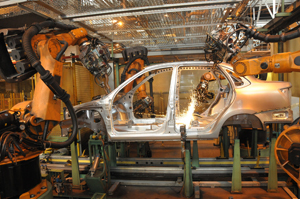 Domestic car sales in Russia grew in November for the first time in almost two years, data from the Association of European Business (AEB) have indicated. According to the AEB, sales grew 0.6% year-on-year in November, after falls of 2.6% in October, 10.9% in September and 18% in August.
Domestic car sales in Russia grew in November for the first time in almost two years, data from the Association of European Business (AEB) have indicated. According to the AEB, sales grew 0.6% year-on-year in November, after falls of 2.6% in October, 10.9% in September and 18% in August.
“November sales were the first in nearly two years (since December 2014) when a positive trend year-over year has been achieved,” said Jörg Schreiber, chairman of the AEB Automobile Manufacturers Committee. He said it was too early to draw any conclusions about this being a permanent shift back into the positive, but added that all eyes would be on the figures for December.
Elsewhere, data from the Russian analytical agency Autostat indicated a doubling in Russian car exports so far this year. In the first 10 months, companies based in Russia exported 19,200 cars compared to only 9,100 in the same period in 2015, excluding exports to traditional CIS (Commonwealth of Independent States) markets such as Belarus and Kazakhstan, according to Autostat.
The figures showed exports to Germany grew tenfold in the period, from just 300 cars last year to 3,300 this year. Exports were also healthy to Egypt (3,000), Latvia (1,700), Lebanon (1,400), China (1,200) and Hungary (1,200), showed the Autostat figures.
However, the exclusion of vehicle exports to traditional CIS markets is significant because they have been hit badly by poor economic and political relations between Russia and its CIS neighbours, including Ukraine and Kazakhstan. While exports to markets in the Middle East and South America are promising in the long term, they will require high investment in logistics and supporting sales outfits. The most promising destinations remain the CIS countries according to insight from market analyst IHS Automotive. However, to take one example, Russia has seen its trade with Kazakhstan suffer this year after the it started levying ‘utilisation fees’ on vehicles imported from Russia, a charge that is meant to the cover the cost of recycling vehicles that is usually considered a way of increasing duties. This charge, together with other duties, has virtually dried up vehicle exports to the country, accounting for a large share in a decline in Russian vehicle exports. Continuing geopolitical tensions between Russia and Ukraine have also suffered. Russian vehicle exports to Ukraine fell 57% last year compared to 2014, to just under 1,800 units.
Nevertheless, Russian OEMs have been making the best of the export opportunities further afield. Carmaker Avtovaz accounted for the biggest growth with 6,500 vehicles exported. Hyundai’s plant in St Petersburg exported 3,100, meanwhile, and VW’s Kaluga plant accounted for 2,200.
Huge plans for 2017Anastasia Tsurkan, manager at logistics services provider Glovis Rus, confirmed there was a rise in export deliveries for Hyundai and Kia over the period and said that from this year, the company was focused on exports not only within the CIS region but also the Middle East, including to Lebanon, Tunisia and Egypt.
Mikhail Moshenko, a spokesperson for Avtovaz, said the company could not yet provide a figure for exports this year. The company stated it was working on a new export strategy, however, the main target of which was to boost the volume of exports next year by 50%.
VW did not comment but has previously declared plans to increase exports, with an emphasis on supplies to Mexico.
Toyota, Chevrolet, UAZ, Renault and Nissan also saw some increase in export sales of their Russian-made cars, but it was less significant, said Autostat. However, Russian carmaker UAZ said it was planning to boost the volume of export sales by 50% next year, primarily targeting new markets in Africa, India and Pakistan.

Exports are clearly increasing in non-traditional markets for Russian vehicles outside the CIS.
“The partial reorientation of Russian car exports to countries outside the CIS is related primarily to the fall in global hydrocarbon prices and the resulting devaluation of the national currencies in most post-Soviet states,” explained Daniel Chirico, managing partner of investment and consultancy firm Kirikov Group. “This is translating into a reduction in effective demand [in those states].”
According to Russia’s Federal Customs Service (FCS), in the first eight months of the year exports to countries outside the CIS were of more value than those to countries within it. The FCS said 14,100 units, worth a total of $336.7m, were exported to non-CIS countries, while 29,100 units were exported from Russia to its CIS neighbours, worth a total of $336m.



































